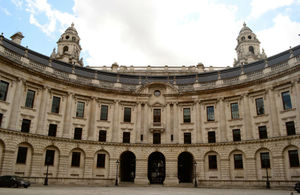Export ban on gem-set gold finial from the throne of Tipu Sultan
Culture Minister Ed Vaizey has placed a temporary export bar on an extremely rare gold gem-set tiger’s head finial from the throne of Tipu Sultan.

Culture Minister Ed Vaizey has placed a temporary export bar on an extremely rare gold gem-set tiger’s head finial from the throne of Tipu Sultan created by the Royal Workshop of Mysore. This will provide a last chance to raise the money to keep this historic item in the United Kingdom.
The Minister’s ruling follows a recommendation by the Reviewing Committee on the Export of Works of Art and Objects of Cultural Interest, administered by the Museums, Libraries and Archives Council (MLA). The Committee recommended that the export decision be deferred on the grounds that the finial is of outstanding significance for the study of Tipu Sultan, his relationship with the rest of India and the British in the sub-continent.
Items connected to Tipu Sultan (1750 - 1799) - the ‘Tiger of Mysore’ - are a source of enduring fascination, closely connected to British history and its long-standing ties to southern Asia. Made of gold and set with diamonds, rubies and emeralds atop a black marble base inscribed with Persian script, the tiger’s head finial formed part of the galleried edge to the throne of Tipu Sultan. It was created as a mark of Tipu’s newly proclaimed independence from the Mughal state in Delhi. After the Siege of Seringapatam by British and allied forces in 1792, the throne was dismantled and the very large amount of gold with which it was covered, along with the canopy and other jewelled parts, were divided amongst the victors.
The finial is a good example of eighteenth century Indian craftsmanship; the item was previously unknown and unstudied by scholars. It is not only of importance on account of its beauty and rarity, but also because of the enigmatic inscription, which may allude to Tipu’s fascination with astrology, dream interpretation and calligrams.
Lord Inglewood, Chairman of the Reviewing Committee, said:
“There are many objects which belonged to Tipu which are still not fully understood. The discovery of this finial could be of key importance to the study of Tipu objects and reveal much more about the man himself and his place in the history of our country, as well as broadening our knowledge of the cultural context of the times in which he lived.”
The decision on the export licence application for the finial will be deferred for a period ending on 15th August 2010 inclusive. This period may be extended until 15th November 2010 inclusive if a serious intention to raise funds with a view to making an offer to purchase the finial at the recommended fair market price of £389,600 net of VAT is expressed.
Anyone interested in making an offer to purchase the tiger’s head finial should contact the owner’s agent through:
The Secretary
The Reviewing Committee on the Export of Works of Art and Objects of Cultural Interest
Museums, Libraries and Archives Council
Grosvenor House
14 Bennetts Hill
Birmingham
B2 5RS
Telephone 0121 345 7428
Notes to Editors
-
For all media enquiries please contact Senior Media Relations Adviser, Sunita Sharma, on 020 7273 8299, e-mail: sunita.sharma@mla.gov.uk. The image is available to download from DCMS’s Flickr photostream.
-
For enquiries on the operation of and casework arising from the work of the Reviewing Committee on the Export of Works of Art and Objects of Cultural Interest (RCEWA) please contact Sean BC Farran, RCEWA Secretary, on 0121 345 7428, e-mail sean.farran@mla.gov.uk
-
The Reviewing Committee on the Export of Works of Art and Objects of Cultural Interest is an independent body, serviced by MLA, which advises the Secretary of State for Culture, Media and Sport on whether a cultural object, intended for export, is of national importance under specified criteria. Where the Committee finds that an object meets one or more of the criteria, it will normally recommend that the decision on the export licence application should be deferred for a specified period. An offer may then be made from within the United Kingdom at or above the recommended fair market price.
-
The details of the finial are:
An important gem-set gold finial in the form of a tigers head from the throne of Tipu Sultan
Mysore (Seringapatam), made between 1787-1793
Gold sheet over a natural resin core, set with rubies, diamonds and emeralds with the head mounted on a black marble pedestal with four gilt-metal claw and ball feet and a partial applique inscription in gilt metal
The head measures 6.9 cm high and 338g; total height with pedestal 17.5 cm -
The motif of the tiger’s head being associated with Tipu is of special interest. The throne was a central element of Tipu’s ideas on kingship with each component of the throne contributing to a better understanding of the whole. The date the finial was made is also important as it was the time when the focus of power in southern India shifted irrevocably to the British.
-
Further details about the tiger’s head finial can be found in the auction catalogue at the Bonhams website.
Press Enquiries: 020 7211 2210
Out of hours telephone pager no: 07699 751153
Public Enquiries: 020 7211 6000